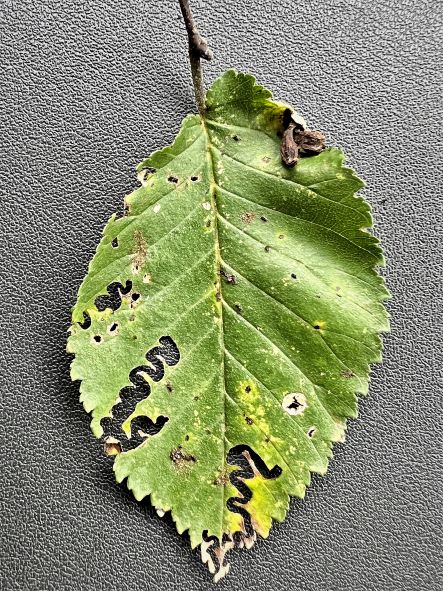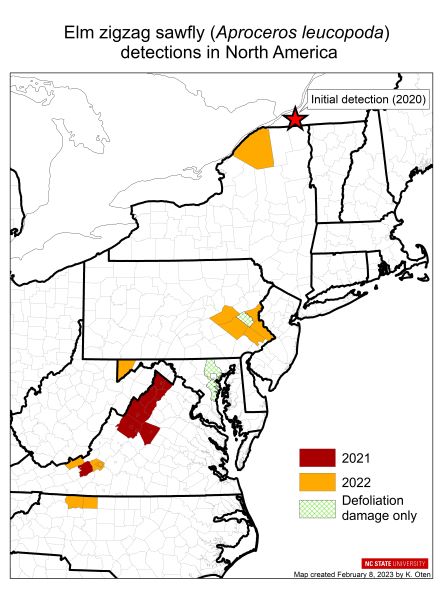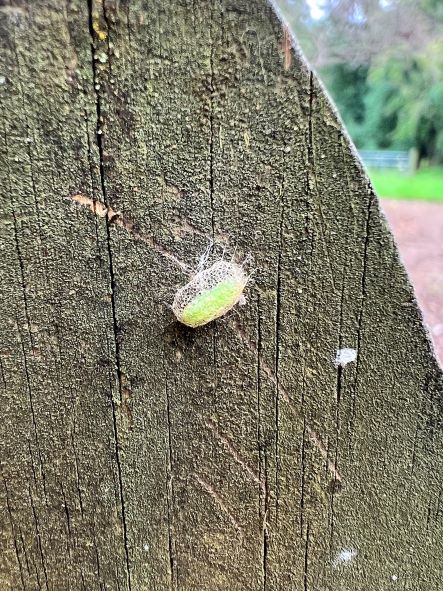Guest blog by Kelly Oten, NC State University
The elm zigzag sawfly [EZS; Aproceros leucopoda Takeuchi (Hymenoptera: Argidae)] is the newest invasive forest insect detected in the eastern US. The colloquially-used common name, currently going through the ESA common name approval process, is not only catchy, but perfectly describes this defoliator’s unique feeding damage. As EZS feeds on elm leaves, it weaves a zigzag pattern from the margin of the leaf towards the mid-vein.
An Expansive — and Quickly Growing – Range
Native to East Asia, the first confirmation of EZS in North America occurred in August 2020 in Québec, Canada when an iNaturalist user posted a photo showing the characteristic zigzag defoliation. The observer realized it was potentially EZS and emailed local entomologists in the province who visited the site, collected specimens, and obtained species confirmation through the Canadian Food Inspection Agency Entomology Lab (Martel et al. 2021). However, this detection was not actually the beginning.
Three months before the Canadian detection, the same defoliation pattern was observed in Frederick County, Virginia, USA. Observers suspected EZS, but no specimens were recovered and therefore identification could not be confirmed. A year later, the site was revisited and this time, bingo—specimens were present and confirmed as EZS. Subsequent surveys that summer led to detections in eight additional Virginia counties. At the same time, the telltale defoliation was observed in Lehigh County, Pennsylvania, USA, but no specimen could be recovered for confirmation. In 2022, EZS popped up more widely; four additional states confirmed EZS: Pennsylvania, North Carolina, Maryland, and New York.
Though new to North America, this insect has a history of invasiveness. First detected in Europe in 2003, it now occupies areas from the United Kingdom and France in the west, to Russia and Kazakhstan in the east (Ashikbayev et al. 2018, iNaturalist 2022).
The strange and unusual biology of elm zigzag sawfly
Like all Hymenopterans, EZS goes through four life stages: egg, larva, pupa, adult. Eggs are laid along leaf margins; after hatching, larvae feed on leaf foliage in a zigzag pattern towards the mid-vein. Older larvae consume the leaf more entirely, leaving behind the mid-vein and thicker lateral veins only. Before pupating, larvae spin a cocoon within which they pupate. Cocoons are seasonally dimorphic; summer pupae (which emerge as adults in 4-7 days) are net-like and attached to leaves or twigs. Overwintering pupae are solid-walled and found in leaf litter or soil. Interestingly, overwintering pupae are not just produced from the last generation of the year. Even early in the summer, overwintering pupae may develop alongside summer pupae. Adults are able to begin oviposition immediately; not only do they not need to feed, but they don’t need to find a mate either! EZS is parthenogenetic, meaning they reproduce without mating. In fact, no male EZS has ever been recorded and it’s believed the species is entirely female.
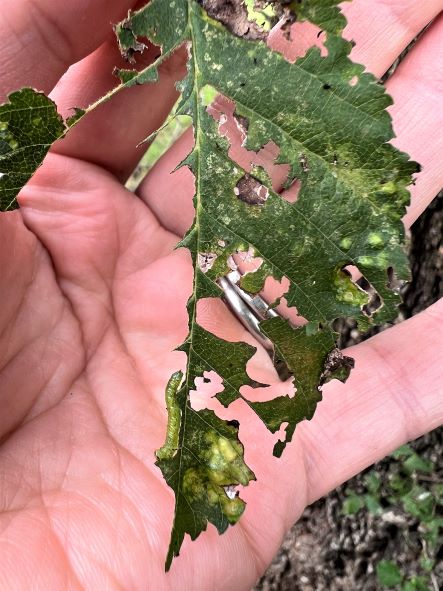
The entirety of this life cycle can last ~20-36 days when not overwintering. However, the voltinism of this pest is highly variable. Papp et al. (2018) recorded up to seven generations in a year on lab-reared colonies, but in nature in Europe, anywhere between two and six generations has been recorded (Blank et al. 2010, Mol and Vonk 2015). In Virginia, two generations were recorded in 2021 and 1 in 2022. It is unknown what factors play into the number of generations per year, but it’s clear that it’s highly variable. The ability of EZS to multiply rapidly and have multiple generations per year suggest large populations can build in a relatively short time. In fact, this was observed in North Carolina in 2022 and in Europe several times before. Large populations are capable of severe defoliation and may cause long-term impacts on tree health.
This collective life cycle description is based on Blank et al. 2010, Martel et al. 2021, Martynov and Nikulina 2017, and Wu 2006.
Spread
EZS has astonished many with how it seems to be popping up all over the place in such a short amount of time. Since 2020, it has been detected in five US states and at several sites along the St. Laurence River in the Canadian province. The adults are strong fliers, capable of spreading 45-90 km (~27-55 mi) per year (Blank et al. 2014). Given the fact they’re parthenogenetic, relatively small numbers can disperse to begin new populations. Of perhaps greater concern is the potential for long-range dispersal. In heavy infestations in North Carolina, cocoons were found not just attached to leaves and stems, but also non-living objects, suggesting a possible mechanism of long-range dispersal should they become attached to vehicles or other objects transported long distances. In addition, EZS damage ranges from minor to severe defoliation. When populations are low and feeding is minor, it’s less likely to be detected unless intentional surveys are conducted. This cryptic nature might suggest it’s in more places than we are currently aware.
So, what’s the big deal?
In short, we don’t know yet. Generally speaking, defoliation by insects causes little long-term harm to tree health but severe and/or repeated defoliation can weaken or sometimes kill a host. In Europe, trees severely defoliated by EZS are typically able to re-leaf but may suffer branch dieback and/or reduced growth (Blank et al. 2010, Zandigiacomo et al. 2011). Also of note, EZS is attacking elm, an already-threatened tree due to widespread mortality cause by Dutch elm disease in the 1900s. Defoliation by EZS could further weaken infected trees or, at the very least, present an additional threat for remaining elms (Blank et al. 2010). While it seems aesthetic damage will be the primary concern with EZS, the potential for long-term tree health impactsin the US is uncertain and should be investigated. For now, anyone that finds EZS or its characteristic defoliation pattern are encouraged to report it to their respective state agriculture or forestry agency.
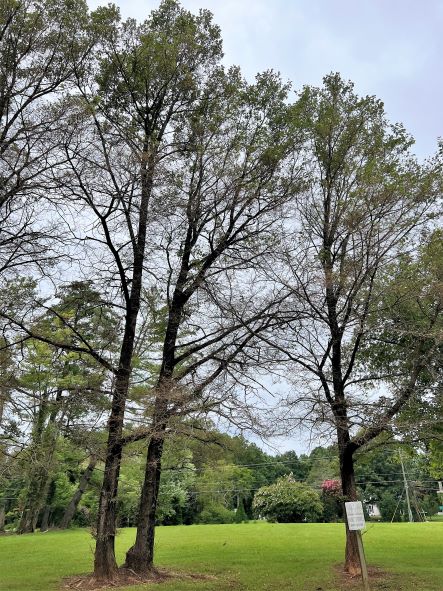
Picture: Kelly Oten, NCSU
[See Faith’s earlier blog about the zigzag sawfly here.]
References
Ashikbayev, N. Z., N. S. Mukhamadiyev, G. Z. Mengdibayeva, M. B. Temirzhanov, and N. K. Kuanyshbaev. 2018. Development of forest entomology in Kazakhstan, pp. 42–47. In T. I. Espolov, K. M. Tireuov, E. I. Islamov, S. B. Baizakov, K. T. Abayeva, E. Z. Kentbaev, and B. A. Kentbaeva (eds.), Actual problems of sustainable development in forestry complex, vol. 2. Aitumar Publishing, Almaty, Kazakhstan.
Blank, S. M., H. Hara, J. Mikulás, G. Csóka, C. Ciornei, R. Constantineanu, I. Constantineanu, L. Roller, E. Altenhofer, T. Huflejt, and G. Vétek. 2010. Aprocerosleucopoda (Hymenoptera, Argidae): an East Asian pest of elms (Ulmus spp.) invading Europe. Eur. J. Entomol. 107: 357–367.
Blank, S. M., T. Köhler, T. Pfannenstill, N. Neuenfeldt, B. Zimmer, E. Jansen, A. Taeger, A.D. Liston. 2014. Zig-zagging across Central Europe: recent range extension, dispersal seed and larval hosts of Aprocerosleucopoda (Hymenoptera, Argidae) in Germany. J. Hymenopt. Res. 41: 57-74.
iNaturalist. Available from https://www.inaturalist.org. Accessed August 2022.
Martel, V., O. Morin, S. Monckton, C. Eiseman, C. Béliveau, M. Cusson, and S. Blank. 2021. Elm zigzag sawfly, Aproceros leucopoda (Hymenoptera: Argidae), recorded for the first time in North America through community science. Can. Entomol. 154: E1.
Martynoz, V. V., and T. V. Nikulina. 2017. Population surge of zigzag elm sawfly (Aproceros leucopoda (Takeuchi, 1939): Hymenoptera: Argidae) in the Northern Ciz-Azov Region. Russ. J. Biol. Invasions 8: 25-34.
Mol, A. W. M., and D. H. Vonk. 2015. De iepenzigzagbladwesp Aproceros leucopoda (Hymenoptera: Argidae), een invasieve exoot in Nederland. Entomol. Ber. 75: 50-63.
Papp, V., M. Ladányi, and G. Vétek. 2018. Temperature-dependent development of Aproceros leucopoda (Hymenoptera: Argidae), an invasive pest of elms in Europe. J. Appl. Entomol. 142: 589-597.
Wu, X. Y. 2006. Studies on the biology and control of Aproceros leucopoda. Plant Prot. 32: 98-100.
Zandigiacomo, P., E. Cargnus, and A. Villani. 2011. First record of the invasive sawfly Aproceros leucopoda infesting elms in Italy. Bull. Insectology 64: 145-149.
